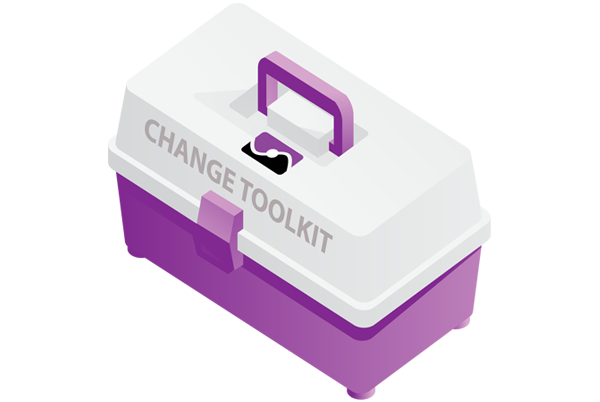At the heart of this toolkit is a set of around 50 well-established business tools. Some you will know well, but others may be new to you. Each tool has been specially written and presented to reflect its effective use at one or more stages of change, with clear, step by step instructions on how to make it work for you. The idea of change as a journey, with distinct stages, is also used a lot in this toolkit.
The Change Toolkit
Change Tools...
H
owever big or small your change, you need people to move along in the desired direction. If you’re stuck somewhere on the change journey, this section can help. It uses the idea of a ‘Change Curve’ to help you understand the journey people take when faced with change – offering tools, techniques and advice for each stage on that journey. And it can help you succeed whether you are leading a big organisational change or facing the everyday changes that come your team’s way.
Even if you’re not stuck, some of these tools can help you think about the best ways to keep your key stakeholders engaged and supportive. They may also help you understand which stage of change you’re in, and what needs to happen next – so you can get things moving. Don’t forget that the Change Curve is a really useful map to have with you on any change journey. If you haven’t already done so, we recommend you take a few minutes to find out more about the Change Curve and how it helps you use this toolkit and select the best tools within it.

Own the problem...
1.Gain Entry
In Gaining Entry, you will be introducing people to the idea of the change. As a change manager, you will often be meeting people for the first time. So this stage is all about empathising with people and establishing trust and patterns of behaviour to get the relationship off on a good footing.
2. Fact Find
Fact Find is also referred to as Joint Diagnosis, and involves gathering lots of information – about the current situation, future aspirations, people’s views and what others are doing.
3. Disengage
During Disengage, you will be helping your stakeholders let go of the current situation and believe that things can be done in a different and better way.
Own the solution...
4. Generate Options
Once people are agreed on the need to change, your next task is to help them to think how they could do things differently. This stage is all about being creative, having fun and exploring possible future states in a safe environment.
5. Select Best Option
As the name suggests, this stage is about picking the option that best helps to solve the issues you’ve identified in Joint Diagnosis. During Select the Best Option, you’ll be focusing on helping people to make a decision.
6. Plan
Having made the decision about how to proceed, you will now be supporting people through a detailed planning phase. In this stage, you can find that people start to feel a little overwhelmed by the scale of the task.
Own the outcome...
7. Implement
In Implement, you are supporting people to deliver the change. This stage is where the change starts to happen and people will begin to work in the new way.
8. Test
During Test, you will be supporting people to make small adjustments to the change in the light of practical experience. This stage is all about ensuring that the change is sustainable and that people will not slip back into their old habits.
9. Embed
During Embed, you will encourage and support the business to make sure the change is sustainable and has become ‘business as usual’. Your stakeholders should be feeling entirely comfortable with the change at this point and confident in their new skills, knowledge and behaviour.
Why use this Change Toolkit?
If you are leading a change project or if your team is having to make changes to what it does and how it works, then this toolkit can help. It uses the idea of a ‘Change Curve’ to help you understand the journey people take when faced with change. And it offers tools, techniques and advice for each stage on that journey.
Across the public sector we’ve identified a need to improve how we lead and support our people through change. We think the ‘people side’ of change is often the weakest link in our change programmes. As a result, a lot of change initiatives fail. And a lot of people experience change at work as difficult, negative and stressful. Now, more than ever, we must change for the better.
You know the best thing about change? It never stands still! Keep up to date with everything to do with change by browsing through our Change Toolkit tools. It’s even better than your average change management website because you can put related stuff in as well as taking it out – and you can leave reviews and recommendations too. Whether it’s a groundbreaking technique, a videolink from an inspirational speaker, some news on related change programmes or a government consultation paper, if it helps us all change for the better then this is where you might find something of value.
So the Change Toolkit is one way in which we can all work together to ‘build capacity’ for successful change. Whether you are the person who has to make change happen, a manager leading a team through change or an individual being asked to do things differently, we hope the information shared between the people using this site can make your life and your job easier!
